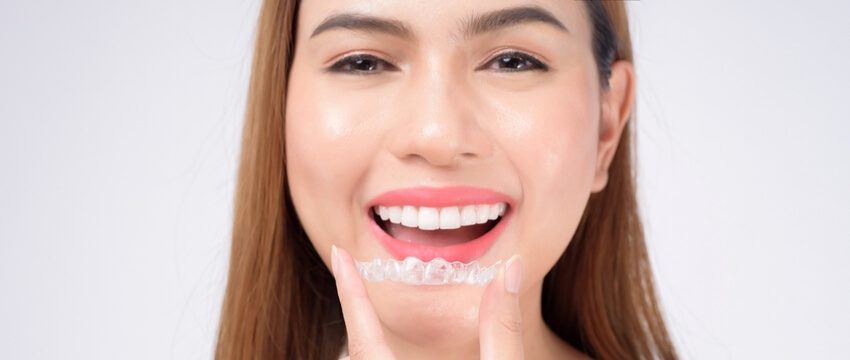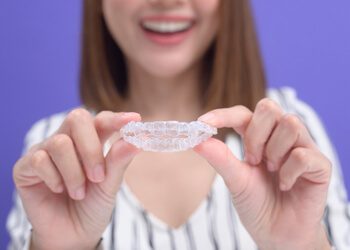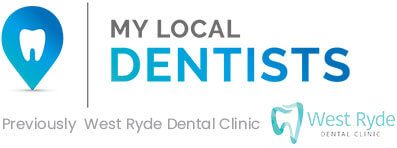
If you are considering undergoing orthodontic treatment to straighten your teeth, you’re almost certain to know about traditional braces. You’ve probably also heard of Invisalign. But how do you know what’s best for you when it comes to Invisalign vs braces? In this post, we’ll discuss the differences and the advantages and disadvantages of each so that you can make an informed decision. Let’s get started…
Braces vs Invisalign – the main difference
The primary difference between traditional braces and Invisalign is that one is a fixed, non-removable treatment, and the other is removable.
So what do we mean by this?
When you opt for traditional braces, you get a permanent set of ‘bracket and wire’ style braces that stay on your teeth for the duration of treatment. This is irrespective of whether you’re sleeping, eating, or cleaning your teeth; they are attached to you 24/7.
On the contrary, Invisalign clear aligners are a series of custom-made removable aligners (known as trays) that sit over the teeth like a clear mouthguard. Because they contain no brackets and wiring and instead harness the power of natural forces to shift teeth into position, they are designed to be fully and easily removable. Unlike traditional braces, they should be removed every time you eat or drink anything but water or clean your teeth. While easy removal has its advantages, you should also be aware that when aligners are not on the teeth, they aren’t working. Therefore, you need to be disciplined to ensure each Invisalign aligner is worn for the utmost time (typically 20-22 hours a day).
Invisalign vs braces – Other differences
Note that I used the plural ‘aligners’ instead of the singular ‘aligner.’ This is because, unlike braces that utilise one device for the duration of the treatment, Invisalign treatment requires the use of multiple custom-made trays. Each tray is designed to move the teeth a tiny fraction – typically just 0.5mm or less. When that particular aligner has done its job, it’s swapped out for the next aligner in the series – usually, this is done every one to two weeks. The idea is that by the time the last tray is worn, your teeth should now be in the desired position. Because clear aligners are custom-made, and there are several of them (anywhere between 12 and 48 depending upon your oral condition), they can be costly, typically anywhere between $3500 and $7000 per treatment.
 Of course, we can’t compare Invisalign vs braces without talking about the apparent difference, and that’s because aligners are incredibly discreet. Invisalign aligners are made from clear polyurethane and are virtually invisible, as the name suggests.
Of course, we can’t compare Invisalign vs braces without talking about the apparent difference, and that’s because aligners are incredibly discreet. Invisalign aligners are made from clear polyurethane and are virtually invisible, as the name suggests.
On the other hand, traditional braces do contain brackets and wires, so unless you opt for lingual (behind the teeth) braces or ceramic tooth-coloured braces, they will be noticeable when you smile.
By the way, if you do opt for something less visible in the fixed orthodontic line, it will affect the price.
What about treatments?
While Invisalign can treat various malocclusions, they aren’t suitable for every orthodontic anomaly. Instead, Invisalign is best used for mild to moderate alignment issues. In contrast, traditional fixed braces can fix pretty much any orthodontic problem, including more complex cases.
Invisalign vs braces which is better?
There are no right or wrong treatments here when it comes to braces vs Invisalign. Both braces types work well in their own right. However, if you are looking to move teeth discreetly, comfortably, and modernly, you might want to opt for Invisalign. Alternatively, if your decision is budget-led, metal braces will do the job equally well, although not as discreet.
If you still can’t make up your mind about the Invisalign vs braces debate and would like a professional opinion, come and talk to the team at My Local Dentists West Ryde. Our highly experienced team can make suggestions based on your needs, requirements, and budget.
Are you ready to book your smile consultation? If so, get in touch with us on (02) 9809 7000 today!
References
Dental.Org – How Braces Work To Cause Tooth Movement
https://www.dentalorg.com/biology-of-tooth-movement.html
Healthline – How Much Does Invisalign Cost And How Can I Pay For It
https://www.healthline.com/health/invisalign-cost
